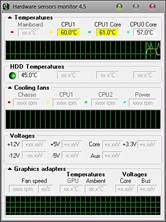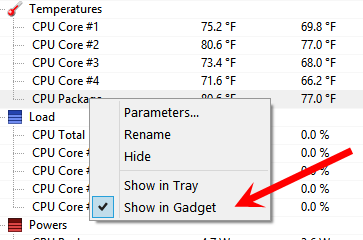

Here is how to check CPU temperature in Windows 11 via the BIOS menu ġ. However, going through the BIOS menu may be daunting for some users, which is why the previous solution is recommended too. This approach doesn’t require installing a third-party application and is pretty straightforward to use. Other programs you can use to check CPU temperature in Windows 11 include:Īnother method you can use to check your CPU temperature in Windows 11 is through the BIOS menu. Visit this page to download the Open Hardware Monitor file. Here is how to use our recommended program to check CPU temperature in Windows 11: Open Hardware Monitorġ. You can, however, prevent this by unchecking the bloatware before starting the installation.
Open hardware monitor cpu temp install#
The only drawback about some of these third-party programs is that they try to install bloatware along with them during their installation.

Besides, they also give some other details about your CPU, such as the number of cores it has, the manufacturer, and many others. These programs work seamlessly and do a good job of showing you the temperature of your CPU. Several programs have been built specifically for monitoring CPU temperature on Windows computers. Check CPU Temperature in Windows 11ĭepending on your preference, you can decide to either check your CPU temperature in Windows 11 using third-party software. Anything above those temperature ranges could mean something with your CPU unless you are gaming or overclocking, where the temperature should max out at 80 degrees Celsius. But when you are using the PC, the CPU temperature could also be around 70 to 80 degrees Celsius, which is not bad. Ideally, a normal CPU temperature should be around 40 to 45 degrees Celcius when your PC is idle or running a very light program. However, you should know the temperature range that’s normal for your CPU, and the one that needs you to quit the heavy task you are performing or tells you that your cooling system is no longer working properly. Now, what CPU temperature is harmful to my CPU? It’s impossible for a CPU not to get hot when being used, which is even why the cooling fans and heat sinks are put in place to help regulate its temperature.

In other words, by keeping an eye on your CPU’s temperature, you are essentially preventing thermal harm to your computer and maintaining CPU performance. The main purpose of regularly checking your CPU temperature is to keep track of the health of your system and ensure that you aren’t causing issues on your computer by performing certain operations. 4 Final Words Reasons to Check Your CPU’s Temperature and Recommended CPU Temperature Range


 0 kommentar(er)
0 kommentar(er)
